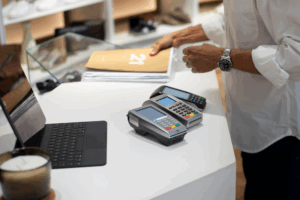
The ROI of Modern POS Systems: A Data-Driven Analysis for Restaurant Owners 2025
In today’s dynamic restaurant industry, the right Point of Sale (POS) system isn’t just a tool for processing transactions—it’s a comprehensive business solution that can significantly impact your bottom line. This detailed analysis explores how modern POS systems are revolutionizing restaurant operations and delivering measurable returns on investment.

The Evolution of Restaurant POS Systems
The restaurant POS landscape has transformed dramatically from simple cash registers to sophisticated management systems. Today’s cloud-based POS solutions offer features that extend far beyond payment processing, becoming central to business intelligence and operational efficiency.
Key Statistics:
- 73% of restaurants report increased operational efficiency after implementing modern POS systems
- Average labor cost reduction of 2-3% through improved scheduling and management
- 95% reduction in order errors with digital POS systems compared to manual methods
Quantifying the Financial Benefits
1. Revenue Enhancement
Modern POS systems directly contribute to revenue growth through:
Faster Table Turnover
- Average table turnover improvement: 15-20%
- Additional revenue potential: $7,000-$10,000 monthly for mid-sized restaurants
- Reduced wait times by 23% through efficient order processing
Improved Order Accuracy
- 98.5% order accuracy with modern POS systems
- Reduction in food waste by 30%
- Customer satisfaction increased by 27%
2. Operational Cost Reduction
Labour Management
- Smart scheduling reduces labour costs by 5-7%
- Automated time tracking saves 5-8 hours of administrative work weekly
- Real-time labor vs. sales analysis enables dynamic staffing adjustments
Inventory Control
- Reduction in food waste: 2-3% of food costs
- Real-time inventory tracking reduces overordering by 15%
- Automated purchase orders save 3-4 hours weekly in management time
Advanced Features Driving ROI
1. Data Analytics and Reporting
- Sales trend analysis
- Customer behaviour insights
- Menu performance metrics
- Peak hour identification
- Profit margin calculation by item
2. Integration Capabilities
- Online ordering platforms
- Delivery service partnerships
- Accounting software
- Customer relationship management (CRM)
- Kitchen display systems
Implementation Best Practices
1. System Selection
- Assess specific business needs
- Evaluate scalability requirements
- Consider integration capabilities
- Review customer support options
- Analyze total cost of ownership
2. Staff Training
- Comprehensive initial training
- Ongoing education programs
- Regular system updates
- Performance monitoring
- Feedback implementation
Cost-Benefit Analysis
Initial Investment
- Hardware costs: $2,000-$5,000
- Software licensing: $69-$150 monthly
- Implementation and training: $500-$1,500
Expected Returns
- Revenue increase: 5-10% in first year
- Labour cost reduction: 2-3%
- Inventory waste reduction: 2-3%
- Administrative time savings: 15-20 hours monthly
Security and Compliance Benefits
1. Payment Security
- EMV compliance
- End-to-end encryption
- Tokenization
- PCI DSS compliance
- Fraud prevention features
2. Data Protection
- Customer information security
- Employee data protection
- Transaction record security
- Backup and recovery systems
- Access control management
Future-Proofing Your Investment
Emerging Technologies
- Artificial Intelligence integration
- Machine learning capabilities
- Contactless payment options
- Mobile ordering features
- Customer-facing displays
Scalability Considerations
- Multi-location management
- Cloud-based operations
- Remote access capabilities
- Customization options
- API accessibility
Measuring Success
Key Performance Indicators
- Transaction speed improvement
- Order accuracy rates
- Table turnover times
- Labor cost percentage
- Inventory variance
- Customer satisfaction scores
- Revenue per employee
- Average ticket size
Implementation Timeline
Month 1-2
- System selection and procurement
- Initial setup and configuration
- Basic staff training
- Test environment setup
Month 3-4
- Full system deployment
- Advanced feature implementation
- Staff proficiency development
- Integration with existing systems
Month 5-6
- Performance optimization
- Advanced feature utilization
- ROI measurement
- System refinement
Conclusion
The investment in a modern POS system represents a strategic decision that can transform restaurant operations. With potential ROI ranging from 70-250% within the first year, the right POS system isn’t just an operational necessity—it’s a competitive advantage. Key success factors include:
- Careful system selection based on specific business needs
- Comprehensive staff training and buy-in
- Regular system updates and optimization
- Continuous monitoring and adjustment
- Utilization of advanced features and analytics




